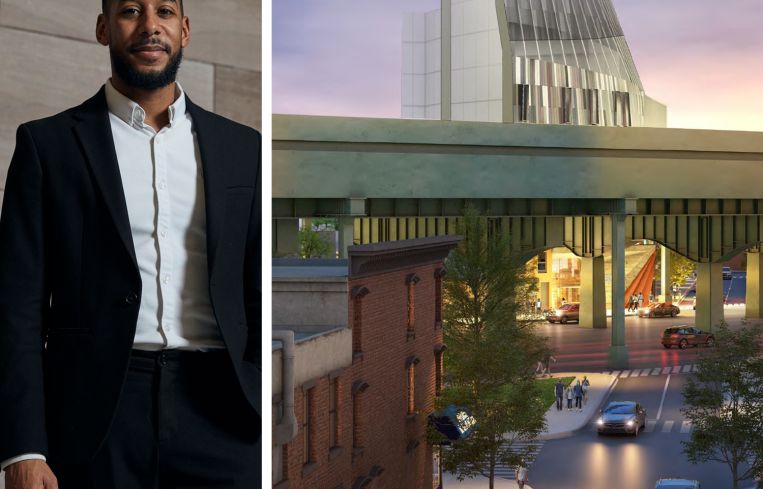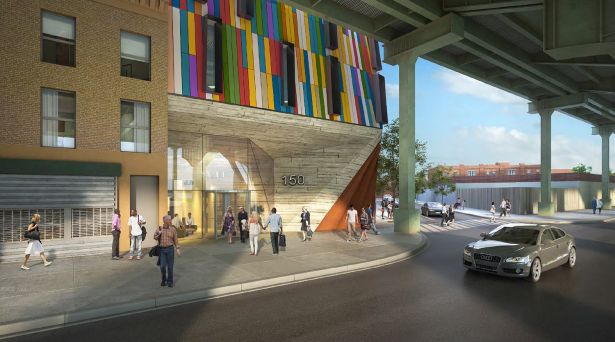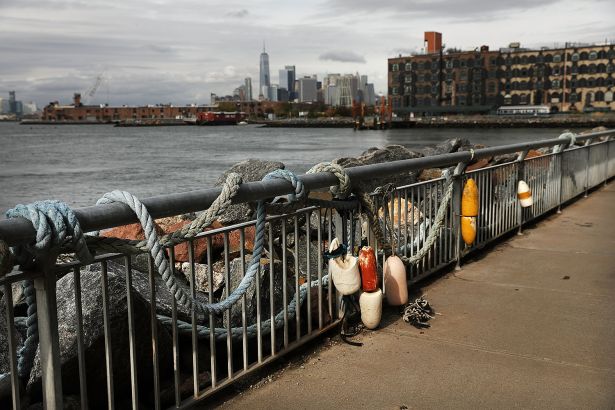A Sleek Office Building in Brooklyn’s Red Hook? That’s the Plan — for Now
Some welcome the 10-story building, while others worry it will change the industrial neighborhood’s character
By Abigail Nehring September 5, 2024 10:00 am
reprints
A Brooklyn scaffolding business underneath the Gowanus Expressway wants to close shop and get into the office market, following pioneers just a few blocks east in Gowanus like XO Projects and Monadnock. But there’s a problem.
Willy Pilku asked the city to rezone the mostly vacant lot at 150 Mill Street to allow him to demolish the small one-story industrial building on it and turn it into a 10-story office building geared toward creative tenants, with a supermarket on the ground floor, according to a zoning application that’s headed to a New York City Council vote this month.
However, luring office tenants is not supposed to be part of the playbook at 150 Mill, which previously housed the Pilku family’s scaffolding rental business. The small, irregular lot is at the edge of the Southwest Brooklyn Industrial Business Zone, where the city keeps real estate interests at bay to preserve manufacturing jobs.
And the proposal is bringing up some existential questions for Red Hook. Some — including local elected officials — have concerns over the project switching a building away from industrial use, while others welcome potential new economic opportunities. Regardless, the ship may have sailed for Red Hook to remain the same as more and more office developments take over Kings County.
“All real estate is Darwinian,” said SVN | CPEX Real Estate founder Timothy King, who’s been brokering deals in the borough for 40 years. “The notion of putting office space in what was once an obscure area is not as outlandish as it sounds.
“You’re not going to see IBM moving there, but tech or media or startups, sure — tenants who pride themselves on being pioneers,” King added.

Thanks largely to the industrial business zone, the waterfront manufacturing enclave has building stock that’s much the same as it was in the 1960s, but today is filled with a patchwork of film studios, self-storage facilities and last-mile distribution centers.
Still, Pilku — who declined to comment — told City Council members during a meeting last week that it has already swayed some tenants to sign onto the project. And those Red Hook pioneers could pay around $40 per square foot for creative office space in the wedge-shaped lot, King estimated, similar to what tenants are paying at a new crop of office buildings on Third Avenue on the opposite bank of the Gowanus Canal.
But local electeds — including Councilmember Alexa Avilés — are concerned about the erosion of the industrial zone, and some in the industry doubt it will succeed given Red Hook’s isolation and lack of mass transit options.
“Nobody in their right mind could think that you can build a spec office building when there are vacant offices stretching all the way through Midtown, with so many in distress right now,” said Ofer Cohen, a longtime commercial broker in Brooklyn and the co-founder of Ailanthus, a new residential development firm.
But Brooklyn Community Board 6 thinks Pilku’s proposal is a net gain for Red Hook, and it voted in favor of the project in April.
Many neighbors also welcome the investment in Red Hook, and are especially excited about the proposed new grocery store, given the dearth of shopping options in the mile-wide manufacturing district that surrounds the borough’s largest public housing project, Red Hook Houses.
“We need to improve Red Hook. We can’t get nothing for our children,” Marcella Williams, a 34-year local resident, told council members at an Aug. 27 hearing on the proposal. “At the supermarket over there, you buy some meat, it stinks. In two days, the lettuce is rotten.”
That did not sway Brooklyn Borough President Antonio Reynoso. He took one look at the sleek glass trapezoid proposed for 150 Mill Street and urged city planners in June to throw it out.
Reynoso wrote in his report that the project contradicts the goals of the industrial business zone, and that the briefcase-toting, white-collar professionals shown in the development’s rendering are a sign of the “continued erosion of industrial land and jobs” in the area.
Avilés — who has not formally voted on the project — echoed Reynoso’s concerns and called for restraint toward projects like Pilku’s in the neighborhood.
“This proposal is speculative,” Avilés said in the hearing. “Mr. Pilku, I know you’re fighting for this property to be an office building that you imagined long ago. But my role here is to protect and guard an industrial business zone that’s being eaten away.”
To assuage those concerns, Pilku promised to lease most of the building to light manufacturing tenants, which wouldn’t be too out of place in Red Hook currently. The Red Hook waterfront is one of 21 industrial business zones scattered across the outer boroughs where companies are rewarded for setting up manufacturing shops, just like the scaffolding business the Pilku family ran for two decades at 150 Mill Street.

The Bloomberg-era initiative is supposed to help preserve the city’s 57,700 remaining manufacturing jobs, which pay higher wages than jobs in the retail and food services sectors even with similarly low barriers to entry.
But Amazon’s arrival on the scene over the past decade undermined those goals, spurring elected officials and a citywide coalition of industrial workers into action to address the scourge of delivery trucks now rumbling through these areas and emitting dangerous amounts of exhaust.
Amazon has faced criticism over the job conditions in its distribution centers in the past, and some argue that the few jobs self-storage facilities need are lower quality than industrial. Plus, film studios — like the one Bungalow Projects is developing at 145 Wolcott Street — aren’t much better, with a state report recently finding employment in the industry around the city hasn’t been growing since 2010. But so far the city hasn’t invited any other type of development to Red Hook.
“This is a good example of what happens when there’s no strategic plan for an area,” said Cohen. “Red Hook needs a plan, and it should include density for housing and storm resiliency, which is still a topic 12 years after Sandy.”
In fact, the New York City Planning Department is about to take a closer look at the city’s industrial business zones and come up with new strategies for spurring development by 2025, thanks to a local law enacted last year.
And it’s not just 150 Mill that threatens to strip away Red Hook’s industrial past. Last week, developer Heights Advisors filed plans to demolish a two-story warehouse just outside the industrial business zone at 159 Van Dyke Street and replace it with a 30,000-square-foot residential property with 20 units.
King wondered if Red Hook could follow nearby areas like the Brooklyn Navy Yard and Industry City in moving away from being an industrial enclave into light manufacturing hubs filled with breweries, sake makers and artisans.
“Look at what David Walentas did in Dumbo, a gritty industrial area that’s now synonymous with luxury and chic,” King said.
Walentas, the billionaire founder of Two Trees Management, is known for his singular role in transforming the cobblestoned waterfront neighborhood of Dumbo thanks to a string of well-timed deals in the 1980s.
Those efforts helped bring performing arts institute St. Ann’s Warehouse to Dumbo two decades ago and eventually lured Etsy to the neighborhood in 2014.
Despite past success, the pandemic, much like in other areas, did not spare Brooklyn’s office market. The borough netted 122,000 square feet of office leases in the second quarter of 2024, a 48 percent drop compared to the previous quarter and 4.7 percent decrease year-over-year, according to a report by CBRE.
And that unsteady nature of the office market makes 150 Mill precisely the kind of speculative development Avilés is wary of.
“This is all about holding folks accountable,” Avilés said in last week’s hearing. “There are a lot of conversations to be had around the city’s archaic laws and the way people get around those things and things move forward, and the benefit for our community doesn’t materialize.”
The City Council’s zoning committee will vote on the 150 Mill Street application this month and, if approved, it will then head to the full council, which generally defers to the local council member on such votes.
Abigail Nehring can be reached at anehring@commercialobserver.com.



